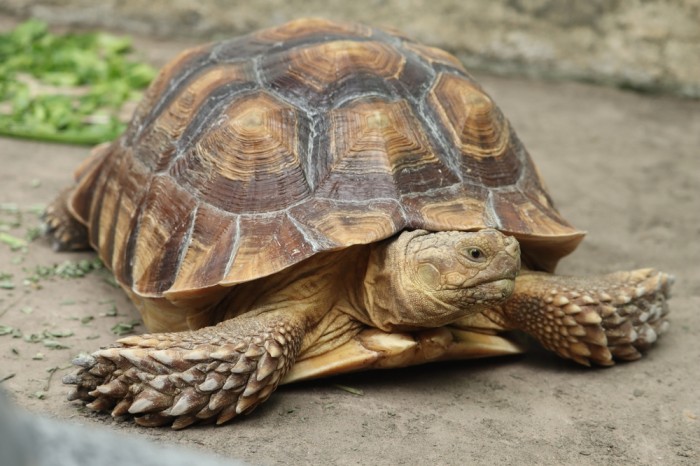Sulcata tortoises, also known as African spurred tortoises, are captivating creatures that have become popular pets for reptile enthusiasts around the world. These giants of the tortoise world are known for their impressive size and unique personalities. However, providing proper care for a Sulcata tortoise is a long-term commitment and requires careful consideration of their needs. In this comprehensive care sheet, we will explore the essential aspects of Sulcata tortoise care to ensure they thrive in captivity.
Habitat and Enclosure
Sulcata tortoises are large, and their enclosures should reflect their size and natural habitat. Here are key considerations for their habitat:
1. Size: Sulcata tortoises can grow to be quite large, with some reaching up to 30 inches in shell length. A suitable enclosure for an adult Sulcata should be spacious, ideally a minimum of 8 feet by 8 feet for a single tortoise.
2. Substrate: Use a substrate that mimics their natural environment, such as a combination of topsoil, sand, and cypress mulch. This substrate will help with burrowing and moisture retention.
3. Shelter: Provide a sturdy shelter to protect your tortoise from extreme temperatures and predators. A wooden doghouse or custom-built tortoise shelter works well.
4. Heating and Lighting: Maintain a basking area with a basking lamp to provide the necessary heat. Additionally, use UVB lighting to help with calcium absorption and overall health.
Diet and Nutrition
A proper diet is crucial for the health and longevity of Sulcata tortoises. Their diet should consist of:
1. Hay and Grasses: Grasses and hay should make up the majority of their diet. Offer a variety of grasses such as Bermuda, Timothy, and Orchard grass.
2. Leafy Greens: Dark, leafy greens like collard greens, mustard greens, and dandelion greens are essential for vitamins and minerals.
3. Occasional Fruits and Vegetables: Offer fruits and vegetables sparingly, as they are high in sugar. These can include carrots, squash, and berries.
4. Calcium Supplements: Dust their food with a calcium supplement to ensure they receive adequate calcium for their shells.
Hydration
Sulcata tortoises require regular access to fresh water for drinking and soaking. Provide a shallow water dish that they can easily access and soak in. Soaking helps with hydration and shedding.
Temperature and Humidity
Maintain the appropriate temperature and humidity levels for your Sulcata tortoise:
1. Temperature: Keep the ambient temperature in their enclosure between 80-90°F (27-32°C). The basking area should be warmer, around 100-110°F (37-43°C).
2. Humidity: Aim for a humidity level of 50-60%. You can achieve this by misting the enclosure and providing a humid hide.
Healthcare and Monitoring
Regularly monitor your Sulcata tortoise for signs of illness or stress. Schedule annual check-ups with a veterinarian experienced in reptile care. Common health concerns include respiratory infections, shell injuries, and parasites.
Types of Sulcata Tortoises
Sulcata tortoises, scientifically known as Geochelone sulcata, are known for their impressive size and distinctive appearance. These gentle giant sulcata are among the largest species of tortoises in the world and are popular as pets and in conservation efforts. While the term “Sulcata tortoise” generally refers to the species as a whole, there are regional variations and subspecies that exhibit subtle differences. In this article, we will explore the various types and subspecies of Sulcata tortoises, shedding light on their unique characteristics and geographic distributions.
1. The Common Sulcata Tortoise (Geochelone sulcata)
The common Sulcata tortoise is the most common type of Sulcata. These tortoises are known for their striking appearance, featuring a high-domed shell and large, curved scales on their legs. They have a natural range across the Sahel region of Africa, which includes countries like Senegal, Mali, Niger, Chad, Sudan, and Ethiopia.
2. West African Sulcata (Geochelone sulcata ‘belli’)
The West African Sulcata, often referred to as Geochelone sulcata ‘belli,’ is a subspecies found in the western part of the common Sulcata’s range. These African sulcata tortoise size are generally smaller, have a slightly different shell shape, and display varying patterns on their legs and carapace. The ‘belli’ subspecies is highly sought after for its unique appearance and is commonly found in the pet trade.
3. Eastern African Sulcata (Geochelone sulcata ‘ruspoliana’)
The Eastern African Sulcata, known as Geochelone sulcata ‘ruspoliana,’ inhabits the eastern regions of the common Sulcata’s range, including Ethiopia and Somalia. They are smaller and more lightly colored than their western counterparts, with distinctive markings on their shells. Due to their specific habitat requirements, they are less commonly encountered in the pet trade.
4. Sahara Desert Sulcata (Geochelone sulcata ‘saharica’)
The Sahara Desert Sulcata, or Geochelone sulcata ‘saharica,’ is a subspecies adapted to the harsh desert conditions of the Sahara Desert. These tortoises have developed unique characteristics to survive in this arid environment, including a lighter coloration and a reduced size compared to other Sulcata types.
5. Tanzanian Sulcata (Geochelone sulcata ‘tanzanica’)
The Tanzanian Sulcata, scientifically referred to as Geochelone sulcata ‘tanzanica,’ is found in Tanzania, a country in East Africa. These tortoises are relatively smaller size and has a unique shell patterns, making them distinct from their West African relatives.
Conclusion
Caring for a Sulcata tortoise is a rewarding experience, but it requires commitment, space, and attention to detail. By providing a suitable habitat, a balanced diet, proper hydration, and the right environmental conditions, you can ensure your Sulcata thrives and lives a long, healthy life. Always strive to learn more about these magnificent creatures to offer them the best care possible.

